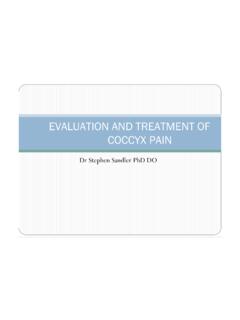Transcription of AAFP Chronic Pain Toolkit
1 AAFP Chronic pain ToolkitHOP20012003* External tools or resources included in this Toolkit do not constitute or imply an endorsement by the American Academy of Family Physicians (AAFP). Views and opinions expressed in external websites or documents do not necessarily reflect those of the AAFP and are intended to help physicians in their treatment of patients with Chronic pain . The AAFP has no control over the content of external websites or accuracy of all content contained by those external ACADEMY OF FAMILY PHYSICIANS1 AAFP Chronic pain ToolkitINTRODUCTIONC hronic pain is common in the , with anywhere from 11% to 40% of the adult population reporting daily Approximately one-third of patients experiencing pain receive a pain While the number of prescriptions for pain management have declined in recent years,3 opioid misuse remains a significant public health crisis.
2 Roughly 21-29% of patients who are prescribed opioids for Chronic pain will misuse The solutions to this public health crisis include continued emphasis on improving Chronic pain care, increasing research into pain and pain management, improving training for physicians who manage Chronic pain , and increased public awareness. Scope and Purpose This Toolkit serves as one primary care solution to assist in the effective assessment, diagnosis, and management of Chronic pain . It provides a brief overview of current evidence, along with useful tools and resources to manage Chronic pain and related issues.
3 These sections and tools can be used together or separately, depending on the needs of the practice. Toolkit Sections*Section TitleDescription Location 1. pain AssessmentOverview of appropriate strategies and diagnostic tools to support Chronic pain assessment in patientsJump to section 2. Functional and Other AssessmentsOverview of strategies and supporting tools for the diagnostic assessment of functional activity and other coexisting conditions in patients, including mental and emotional health, quality of life, and other psychological factorsJump to section 3.
4 pain Management Overview of strategies and considerations for effective acute and Chronic pain management in patients Jump to section 4. Opioid Prescribing Overview of opioid prescribing as related to the treatment of Chronic pain , including information and resources for safe prescribing; risk mitigation and monitoring; opioid conversion and tapering tools; and opioid resources for patientsJump to section 5. Opioid Use Disorders: Prevention, Detection, and RecoveryOverview and resources to support opioid use disorder prevention; recognition and assessment.
5 And treatment and recoveryJump to section AcknowledgementsWe would like to thank the following individuals for their contributions to the content and design of the of Family Medicine Experts: AAFP Project Leadership Team: Benjamin Crenshaw, MD Cory Lutgen, BSCarissa van den Berk-Clark, PhD, LMSW Melanie Bird, PhD, MSAMD aniel Mullin, PsyD, MPH Natalia Loskutova, MD, PhDLynn Fisher, MDMolly E. Rossignol, DO, FAAFP, FASAMW ayne Reynolds, DOThe AAFP Chronic pain Toolkit was developed by the AAFP with funding support (in part) by grant no. 6H79TI080816 from the Substance Abuse and Mental Health Services Administration (SAMHSA).
6 The views expressed in written conference materials of publications and by speakers and moderators do not necessarily reflect the official policies of the Department of Health and Human Services (HHS); nor does mention of trade names, commercial practices, or organizations imply endorsement by the Centers for Disease Control and Prevention. Prevalence of Chronic pain and high-impact Chronic pain among adults United States, 2016. MMWR. 2018;67(36) Harrison JM, Lagisetty P, Sites BD. Trends in prescription pain medication use by race/ethnicity among US adults with noncancer pain , 2000-2015.
7 Am J Public Health. 2018;108(6) Centers for Disease Control and Prevention. opioid dispensing rate maps. Accessed January 7, 2021. #:~:text=The%20overall%20national%20opio id%20dispensing%20rate%20declined%20from %202012%20to,than%20153%20million%20opio id%20prescriptions 4. National Institute on Drug Abuse. Opioid overdose crisis. Accessed January 7, 2021. HOP20012003 pain ASSESSMENT | Section 1 AAFP Chronic pain ToolkitOVERVIEWA ssessment of Chronic pain should be multidimensional. Consideration should be given to several domains, including the physiological features of pain and its contributing factors, with physicians and other clinicians assessing patients for function, quality of life, mental health, and emotional health.
8 In addition to a complete medical and medication history typically obtained at an office visit, documentation should be obtained about pain intensity, location, duration, and factors that aggravate or alleviate pain . A physical exam should include musculoskeletal and neurological components, as appropriate. Diagnostic testing and imaging may also be considered for some types of Chronic pain . Many organizations, including the AAFP, recommend against imaging for low back pain within the first six weeks of treatment unless there are reasons for the imaging.
9 These reasons may include concerns of underlying conditions, such as severe or progressive neurological deficits, or if osteomyelitis is Periodic reassessments of Chronic pain and treatment should focus on evaluating improvements in physical health; mental and emotional health; progress towards functional treatment goals; and effectiveness and tolerability of medications for Chronic pain treatment . Currently, there are no universally adopted guidelines or recommendations for assessment of Chronic pain . The use of appropriate assessment tools can assist in diagnostic assessment, management, reassessment, and monitoring of treatment effects.
10 Multiple tools are available, with many embedded in electronic health record (EHR) systems. pain Assessment ToolsThe table on the next page includes selected tools for pain assessment included in this Toolkit , along with links and reference to additional tools. Assessments about other relevant domains are covered in Functional and Other Assessments (Section 2). AMERICAN ACADEMY OF FAMILY PHYSICIANS2 AMERICAN ACADEMY OF FAMILY PHYSICIANS3 AMERICAN ACADEMY OF FAMILY PHYSICIANSPain Assessment Tools in Toolkit NameUseScoring DescriptionLocationBrief pain Inventory (BPI) Short Form Assess pain severity and impact on daily function Worst pain score: 1-4 = mild pain Worst pain score: 5-6 = moderate pain Worst pain score.













